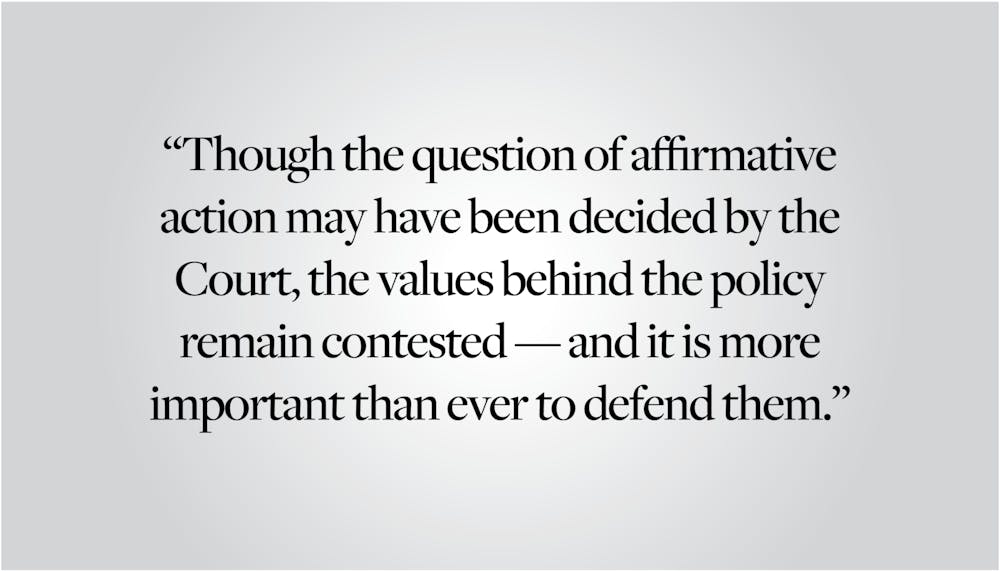On June 29, the Supreme Court, in a decision penned by Chief Justice John Roberts, ruled that the use of race-based affirmative action in college admission processes “cannot be reconciled with the guarantees of the Equal Protection Clause.” Though the ruling was long expected, its announcement sent ripples through higher education, as people rushed to either celebrate or mourn the loss of a policy that had played a key role in the college admissions process since at least the 1960s.
In December, this board wrote that “a blanket ban on affirmative action would undermine our admission process.” Now that such a ban has become a reality, the University must find the best path forward in an uncertain administrative and legal landscape. Though the question of affirmative action may have been decided by the Court, the values behind the policy remain contested — and it is more important than ever to defend them.
In a message to the Brown community hours after the ruling was released, President Christina Paxson P’19 P’MD’20 affirmed that Brown will “remain firmly committed to advancing the diversity that is central to achieving the highest standards of academic excellence and preparing our students to grow and lead in a complex world.” Faculty and administrators at other universities, including Harvard and Penn, where affirmative action has long helped steadily build more diverse student bodies, expressed similar sentiments. Diversity at these institutions — not only in terms of race, but also gender, sexuality and socioeconomic background — is not an arbitrary goal. Not only is it necessary to counter past and present-day forces of discrimination and oppression, but students of all races at higher education institutions benefit immensely from learning and forming relationships in a diverse environment.
In her statement, Paxson also noted that senior administrators at Brown have been working to develop a number of “lawful strategies” to ensure diversity among recruited and accepted students at Brown. It’s possible that these strategies might look like California State University’s Equal Opportunity Program, which focuses on educational and economic disadvantage. It also might mean a greater emphasis on personal statements or “identity essays” where applicants could outline the importance of their racial or ethnic identities in shaping their perspectives — one of the few carveouts for the consideration of race left in Roberts’s decision. Or perhaps Brown might finally drop legacy admissions, a long-outdated practice that advantages the wealthy and connected.
There are those who would argue against the use of any measures meant to replicate the effects of affirmative action. Critics such as Justice Clarence Thomas and Students for Fair Admissions have argued that such policies actually undermine students of color, causing them to feel they don’t truly belong at the institutions to which they matriculate. But these arguments fail to account for the harm that students experience when they are entirely denied an institutional acknowledgement of the impact of race on their lives. In her dissenting opinion, Justice Ketanji Brown Jackson carefully outlines the history of systemic racism towards Black Americans — racism upheld and institutionalized through a series of legal decisions, laws and policies that curtailed generations of economic and political opportunity.
To celebrate the end of affirmative action, to understand any use of race in admission or hiring processes as an act of discrimination, requires believing the United States to be a color-blind nation. As Jackson’s dissent — and the lived experiences of countless Americans of color — demonstrates, this never has been, and is not now, the case.
In her dissenting opinion, Justice Sonia Sotomayor writes that “universities can and should continue to use all available tools to meet society’s needs for diversity in education.” In order to make good on what Paxson has correctly identified as its “vitally important commitments to access and diversity,” Brown must identify those tools and implement them.
Affirmative action is gone, but what comes next is far from clear. The actions that Brown takes in the coming months will determine the scale of the loss — and the opportunities for fostering diversity on College Hill in the years to come.
Editorials are written by The Herald’s editorial page board and aim to contribute informed opinions to campus debates while remaining mindful of the group’s past stances. The editorial page board and its views are separate from The Herald’s newsroom and the 133rd Editorial Board, which leads the paper. This editorial was written by the editorial page board’s editors Kate Waisel ’24 and Devan Paul ’24, as well as its members Alissa Simon ’25 and Yael Wellisch ’26.





